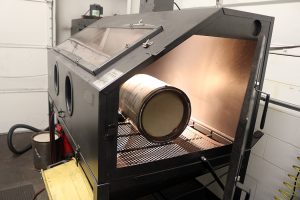
Keeping your diesel particulate filter (DPF) clean and operating properly is paramount to your truck’s performance and longevity. My name is Steve Shurina and I work with DPF Alternatives, a company that focuses on cleaning and maintaining aftertreatment systems. During my initial experience with DPF cleaning, I encountered some filters that had a pinkish tint. Various factors could contribute to this occurrence. However, I discovered that the most common reason was the use of a product called Max Mileage. Interestingly, when DPFs were cleaned with Max Mileage, they appeared to be in excellent condition, with finer ash content and looser ash. Additionally, the ash and soot didn’t adhere as strongly to the cell walls of the substrate.
Upon further investigation, I learned that Max Mileage operates at a lower combustion temperature. This lower temperature helps prevent DPF cracking, melting, excessive pressure buildup in the cells, and face plugging. As you can imagine, the cost of replacing a DPF or diesel oxidation catalyst (DOC) is significant. Once the precious metals in a DOC are depleted due to the high heat, pressure, or face plugging, they cannot be restored.
In my experience of cleaning hundreds of DPFs and DOCs, I have never encountered a failure in those that faithfully utilized Max Mileage. While sharing this information might mean less cleaning work for me, it could save you money. Additionally, suppose you regularly use Max Mileage and have your filter cleaned by DPF Alternatives (referred to as Stage 5 cleaning). In that case, you will receive a lifetime warranty for the usable lifespan of the filter.
Indications of a malfunctioning DPF include: 1) Black soot on the outlet side or clean side of the filter; 2) Airflow below the OEM factory specifications; 3 The pin test producing inconsistent results, with the pin going all the way through the DPF; 4) A light test revealing bright light passing through the cells; and 5) Visual signs of either stepping or cracking on the substrate’s surface.
At DPF Alternatives, we thoroughly test for all these issues. Our Stage 4 and 5 cleaning process incorporates the following steps. Visual inspections. Pin tests. Airflow tests. Utilizing an air knife to inspect ash content and flow. Second airflow test with an inspection. Water bench testing with pressurized air and water. Using an air knife to remove any excess water and ash. Ultrasonic bath. Air knife to remove excess water. Gradual kiln drying at a temperature of 1,112 degrees Fahrenheit overnight. Air knife to remove any remaining fine ash. Light test. Then a final flow test. By following this comprehensive cleaning process, we ensure the optimal performance and longevity of your DPF by bringing it back to 99% of OEM specifications.
Moving on to another subject, let’s talk a bit about the dangers of doing it yourself. Recently we had an exciting challenge come through the shop. This customer had attempted to do a transmission swap (from automatic to manual) with his friends on his Western Star. Not a big deal, right? You’ve done that several times over the years, whether putting in a rebuild kit, replacing a bearing, or swapping entirely. Here’s the rub, though. Gone are the days of simple 8-bolt transmission drops – now we are faced with the headache that is the Transmission Control Module (TCM). It should be as simple as it sounds. Disconnect the harness, and there is your shiny new manual. At least, that’s how we would all want it to go.
The truth is slightly more annoying and a tiny bit more involved. What nobody will tell you is that the TCM is not just for controlling the transmission shifting points, it also monitors speed, and is annoyingly connected to a starter lock-off solenoid. You can see it now. You just finished the installation, and you’re stoked that you just completed the job with no issues. It almost went too smoothly. You go to start the truck to take her out for a spin, turn the key, and nothing. You don’t even get that annoying click when the batteries are dead. At this point, you can just scratch your head and wonder what went wrong.
This is one of many issues when removing an automatic. A few other issues rear their heads when you find out that you now have to wire in a speed sensor to the transmission to get your speedometer working correctly and reprogram the clutch switch. We do not want to deter people from doing their own work, far from it. All owner operators should have an intimate knowledge of their vehicles and save as much money as possible by implementing that knowledge. The issue with DIY is that if you are unfamiliar with the process, you can sometimes start digging a hole that can be difficult to get out of.
We at Pittsburgh Power will never put a driver down for trying something alone. We want to see you succeed by giving you the tools you require, and if you run into an issue, we are always here to help. For great information on repairs and the trucking industry as a whole, listen to us on Sirius XM (The Pit Stop with Dave Nemo) Mondays at 11:00 AM on Channel 146, or on the “Lets Truck” App (The Power Hour with Kevin Rutherford) Tuesdays at 10:00 AM. Thanks to Steve Shurina and Jordan Greathouse for their contributions to this column. Comments or questions? Stop by our shop in Saxonburg, PA, call (724) 360-4080, or visit www.pittsburghpower.com anytime.

